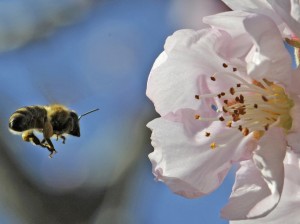Washington, DC–(ENEWSPF)–October 21, 2013. A study conducted by Sussex University researchers has identified the garden plants most attractive to pollinating insects. The study’s findings are important as pollinating insects are declining globally and are facing growing habitat losses. The study also gives vital scientific information to individuals and communities on plants that are most beneficial to pollinators. Although creating pollinator friendly habits is an important step to slowing pollinator population decline, environmental groups and activists are focused on addressing the underlying problem that leads to pollinator population loss: the continuous use of toxic pesticides.
The study, Quantifying variation among garden plants in attractiveness to bees and other flower-visiting insects, published in Functional Ecology, collected data over two summers by counting flower-visiting pollinators on 32 popular garden plant varieties to determine which varieties are more attractive to pollinators. The study found that the most attractive flowers are 100 times more attractive than the least attractive flowers. According to the study, the most attractive flowers are borage, lavender, marjoram, and open-flower dahlias. Majoram was the best all-round flower, attracting honey bees, bumble bees, other bees, hover flies, and butterflies. While information on pollinator friendly flowers is widely available, this study was designed to, “put that advice on a firmer scientific footing, by gathering information about the actual number of insects visiting the flowers to collect nectar or pollen,” according to study co-author Francis Ratnieks, Ph.D., quoted in a BBC article.
The study’s findings have several interesting implications. First, planting pollinator friendly plants does not involve extra cost or gardening effort, or loss of aesthetic attractiveness, as these flowers are not more expensive or more time consuming to plant than non-pollinator friendly flowers. The study authors acknowledge that while their sample of 32 plants is limited, the results should encourage further research to develop more scientific understanding of those flowers most attractive to insect pollinators. This study can also help cities and towns plan which flower varieties to plant in parks and public spaces so they can increase biodiversity and support pollinators.
Beyond Pesticides recently released its own BEE Protective Habitat Guide, which provides information on creating native pollinator habitat in communities, eliminating bee-toxic chemicals, and other advocacy tools. This habitat guide is part of the BEE Protective campaign launched by Beyond Pesticides this past Earth Day. The grassroots campaign is part of a larger effort to protect bees from rapid declines spurred by Colony Collapse Disorder (CCD) and other hazards associated with pesticides. The launch came one month after beekeepers, Center for Food Safety, Beyond Pesticides, and Pesticide Action Network North America filed a lawsuit against EPA calling for the suspension of certain neonicotinoid pesticides.
Pesticides, specifically neonicotinoids, have increasingly been linked to bee declines. These chemicals are used extensively in U.S. agriculture, especially as seed treatment for corn and soybeans. Agriculture is not the only concern however, as pesticide applications in home gardens, city parks, plant nurseries, and landscaping are also prime culprits in the proliferation of these harmful chemicals. The systemic residues of these pesticides not only contaminate pollen, nectar, and the wider environment, but have repeatedly been identified as highly toxic to honey bees.
A recent example of neonicotinoids’ toxic effects on bees was the massive bee death in Wilsonville, Oregon. 50,000 bumblebees were found dead or dying in a shopping mall after dinotefuran, a neonicotinoid pesticide, was applied to nearby trees. After this incident the Oregon Department of Agriculture (ODA) placed a temporary restriction on the use of pesticides with the active ingredient dinotefuran and the Oregon State University Extension Service revised its publication, “How to Reduce Bee Poisonings from Pesticides”. The publication contains research and regulations pertaining to pesticides and bees and describes residual toxicity periods for several pesticides. Though this temporary restriction and revised guide are important steps that acknowledge the effects neonicotiniod pesticides have on pollinators, they should only be viewed as the initial steps towards a complete ban on neonicotinoid pesticides.
Take Action: Beyond Pesticides’ BEE Protective campaign has all the educational tools you need to stand up for pollinators. Some specific ways you can help are:
- Join us in asking Lowe’s and Home Depot and other leading garden centers to take action and stop the sale of neonicotinoids and plants treated with these chemicals.
- Tell your member of Congress to support the Save America’s Pollinators Act.
- Sign the Pesticide Free Zone Declaration and pledge to maintain your yard, park, garden or other green space as organically-managed and pollinator friendly.
- Use our model resolution to transform your community and raise awareness about pollinator health.
For information on what you can do to keep the momentum going, see www.BEEprotective.org.
Sources: BBC, http://www.beyondpesticides.org
All unattributed positions and opinions in this piece are those of Beyond Pesticides.








